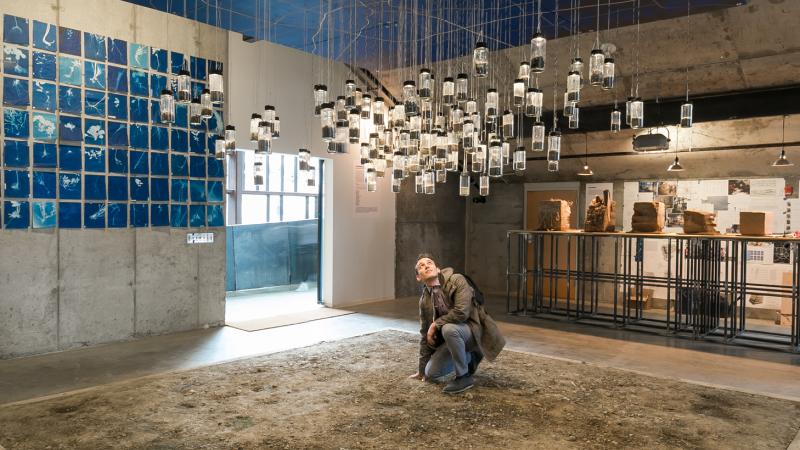Columbus Dirt: Illuminating the Invisible
“Dirt then, is never a unique, isolated event. Where there is dirt there is a system.”
- Purity and Danger, Mary Douglas
It sustains organic life and supports the built environment. Beneath grass and pavement, dirt abides, integral to life but largely taken for granted, according to Associate Professor of Landscape Architecture Paula Meijerink, whose exhibit, COLUMBUS DIRT: Illuminating the Invisible, is on display in the Knowlton School’s Banvard Gallery from March 7 through March 30.
“We want someone who visits the exhibit to have a new appreciation of soil,” Meijerink explains. “The various components of the exhibit are essentially about soil research, proposition and implementation. The idea is to demonstrate the richness and diversity of soil on one hand, and also explore the question central to this exhibit: 'How can soil be experienced and initiate new ecologies?'"
Catching the eye immediately is the Soil Chandelier hanging in the middle of the Banvard Gallery. Suspended from an overhead map of Columbus, 137 illuminated glass jars contain samples of soil collected in areas of compromised, human-altered conditions around the city. A common misconception is that all soils in a city have been transformed to the point where the original qualities have all but disappeared, thus becoming “urban soils.” With soils being formed by glacial and hydrological processes, however, there is great diversity. The samples that form the chandelier highlight this variety in mineral structure, alkalinity and organic content. Beneath the Soil Chandelier, a 14-by-14-foot frame contains a swatch of soil from Ohio State’s Waterman Farm, from which new grass seedlings have begun to appear.
Built from Waterman Farm soil, the Dirt Wall makes the invisible visible by demonstrating the ancient construction technique of rammed earth walls. At a height of 47 inches and a length of 12 feet, the wall is comprised of Waterman Farm soil, amended with additional sand, that is highly compacted. Added to the sand are layers of charcoal, straw, wood chips and books. The introduction of organic material and access to water in the wall allows plants to grow. This capacity to initiate plant life introduces the concept of the dirt wall, which presents new possibilities for this old construction method. “The role this technology can play in creating new ecological spaces is highly interesting,” stated landscape architecture student John Bargiel. “It can be adapted to create a site specific ecology with materials found on site. It brings a dynamic bit of nature back to cityscapes in a remarkably simple way.”
The exhibit uses the Columbus highway system as a field of exploration to investigate specific ways this old technology can be implemented. The Road to New Ecologies display presents eight models with technical drawings that illustrate how the Dirt Wall technology can replace common vertical highway conditions. “There is great opportunity to create new ecologies in these areas while simultaneously finding a sustainable replacement for noise barriers,” stated landscape architecture student Bailey Moore. “These walls could also bring more vegetation into urban environments as they can be scaled vertically and have a reduced footprint compared to traditional planting strategies.” The models articulate opportunities employing rammed earth technology by displaying prototypes for a Tree Wall, Lichen Wall, Rose Wall, Butterfly Wall and Bee Wall, among others. These walls can enrich biodiversity at the same time they replace traditional highway structures such as retaining walls, cheek walls and jersey barriers.
The Cyanotype Prints display contributes to the exhibit’s imagined soil-sustaining ecologies and references the introduction of organic plant life to the proposed rammed earth walls along the Columbus highway system. The root systems captured by the cyanotype process, like the soil specimens displayed in the Soil Chandelier, were collected in compromised conditions. The print arrangement on the wall is determined by a root system’s decreasing aptness for growth in wall cavities: fibrous and rhyzomatic roots on the left of the wall with taproots to the right.
Revealing traces of the research process that led to the construction of the Dirt Wall, the Gallarage is a curated assemblage of materials that evoke a garage-like atmosphere of scattered miscellany. Displayed on a table surface made from the wood formwork of the Novel Wall are books, wall mock-ups, soil testing kits, soil bottles, research binders, cyanotype materials and various tools.
“Introducing organic life—flora and fauna—is fundamental to what we do as landscape architects, and in this field we bring a great contribution to our collective environment,” commented Meijerink. “Soil sustains this life and is essential to how we approach our design work.”
Much of the research and soil collection for the exhibit occurred during the 2017 fall semester seminar, Scarlet Jungles, which examined nature and biological life in human-altered conditions. Fifteen students, many from the seminar, participated in the design and creation of the gallery exhibit through an independent study, Columbus Dirt.
“Working on the exhibit has definitely cultivated a better appreciation for dirt and its crucial role in the global ecosystem,” added Moore. “The value of dirt is often overlooked but through this exhibit we hope to convey that even local soils can be used in unique instances.”


